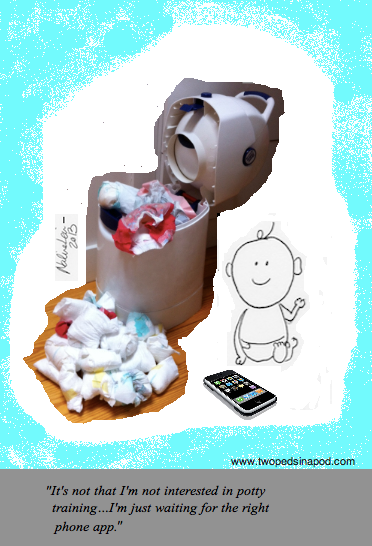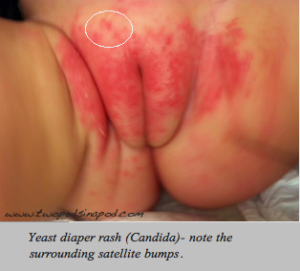
Bummed about diaper rash? Despite what your grandmother says, teething is not the underlying cause of diaper rash. The underlying cause of all diaper rash is, well…the diaper! Whether your baby wears cloth or plastic diapers, the first treatment for diaper rash is to take the diaper off.
Yuck, you say? We agree. This first treatment isn’t practical. Fortunately there are other ways to combat these common diaper rashes:
Contact rash
This diaper rash appears as patches of red, dry, irritated skin. Poop smooshed against a baby’s sensitive skin is the main source of irritation for this type of rash. Contact rash is often accentuated where the elastic part of a plastic diaper rubs against the skin. Experiment to see if one brand of disposable diapers causes more irritation than others or if the detergent used for a cloth diaper is the culprit. Even the soap on a wipe or the friction from scrubbing off poop can exacerbate a contact rash.
Treatment: If you see a rash, use a soft, wet cloth with a gentle moisturizing soap to clean off poop or splash water gently on your baby’s bottom. Try to avoid rubbing an already irritated bottom—splash and dab, don’t scrub. Grab a water bottle with a sports top and fill it with warm water to squirt on raw skin. Even better, grab mom’s squirty-bottle that she used right after delivery for cleaning, and use that to avoid rubbing baby’s bottom.
Just urine in the diaper? Just pat or fan dry the bottom and change the diaper. Don’t bother to wipe all of the urine off. After all, urea, a component of urine, is used in hand creams. In addition, after every diaper change apply a barrier cream (one containing zinc oxide or petroleum jelly) to prevent your baby’s skin from coming into contact with the next round of irritants.
 Yeast rash
Yeast rash
This rash is caused by a type of yeast called Candida. The rash typically looks beefy red on the labia or the scrotum. “Satellite lesions” or tiny red bumps surround the beefy red central rash. Babies on antibiotics are particularly susceptible to candidal rashes. Yeast love warm, wet, dark environments so remove the diaper as much as possible to create a cool, dry, light environment.
Treatment: Since yeasts are a type of fungus, yeast rashes respond to antifungal creams. Examples are clotrimazole (sold over the counter as Lotrimin in the anti-foot fungus aisle of your pharmacy) and nystatin (prescription). Anytime you use a medicated cream, remember to put a barrier protection on top to prevent contact irritation. Treatment can take as long as 2-3 weeks. Even if the yeast rash disappears within less than two weeks, to insure the yeast stays away, treat for a couple days afterwards.
Pimples
Sometimes you will see a pimple, or a several pimples, in the diaper area . Pimples that look like they have pus inside of them are usually caused by overgrowth of bacteria that live on the skin or around poop. Sometimes a tiny pimple transforms into a boil, or abscess. Suspect an abscess when a pimple grows, reddens, and becomes tender.
Treatment: In addition to usual washing poop off with soap and water, apply an over-the-counter topical antibiotic cream or ointment to the pimples with diaper changes. Soak your baby’s bottom in a bath a couple of times a day in warm water. If you suspect a boil or abscess, take your baby to her doctor who may drain the infection and/or prescribe a prescription topical or oral antibiotic.
Eczema
If your baby has red, dry, itchy patches on her body she may have eczema. This eczema may appear anywhere… including in the diaper area.
Treatment: In addition to applying barrier creams, treat eczema in the diaper area with hydrocortisone 1% ointment four times daily for up to one week.
Viral- Viruses such as molluscum contagiosum may cause flesh colored bumps in the diaper area. Other viruses, like the ones which cause hand-foot-mouth disease, may cause red bumps in the diaper area. Be suspicious of hand-foot-mouth disease if your see red bumps on your child’s hands and feet as well as sores in her mouth.
Reasons to bring your child to her doctor: If you are unsure of the cause or treatment for your baby’s diaper rash, then it’s time to call your pediatrician. Don’t worry… no one will think you are acting rashly.
Julie Kardos, MD and Naline Lai, MD
©2017, updated from 2014 Two Peds in a Pod®



